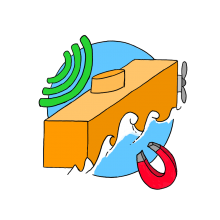Autonomous Underwater Vehicle
Background
The Autonomous Underwater vehicle project is a student-led group of Mechanical Engineering students working with Professor Camilo Velez to study and manufacture a swarm of small scale robots. Our inspiration for this project stems from the idea that nano robots can work together to detect, isolate and remove a single cell in the human body. In an effort to work towards this idea, our team is set to construct a number of small-scale robots that can autonomously navigate in a swimming pool to detect and attach magnetically to a specified item.
Goal and Objectives
- Team Organization and Project Definition (Week 2)
- Break down the functions of the robot into smaller individual tasks and find the optimal parts and sensors for our robot’s functions. (Week 3-4)
- Create a virtual prototype of the robot with every required component and optimize how those components will work together. (Week 5)
- Test the individual components of the robot. (Week 6-7)
- Manufacture the first prototype of the robot and combine all the components for additional testing. (Week 8-9)
- Complete the first prototype and realize our goal of having the robot attach autonomously to a specified item on the bottom of a swimming pool (water tank). (Week 10)
Required Functions
1) The robot will use a set of motors that will be connected to a microcontroller to drive the propellers and displace it. It will also use a stepper motor to control a syringe that will modulate the water inside it to adjust the buoyancy.
2) A stepper motor will be used to pull/push the plunger of a syringe inside the robot to intake water/ release water and increase/decrease the density of the robot, allowing it to float and sink to the desired level underwater.
3) For the connection of the robots, electro-magnets will be used. These electro-magnets create a magnetic field once current is applied to it. On the opposite side of the robot, a metallic strip will be used to connect the electro-magnet to. For a more advanced prototype, smaller electropermanent-magnets are being considered as a possible alternative to the electro-magnets.
4) The robot will be using a combination of acoustic and magnetic sensing to navigate its way towards its objective. For long range navigation the robot will be using a set of microphones to detect a sound source coming from the end position and will work in conjunction with the propulsion to swim towards the higher intensity sound. Once it is in range of the magnetic field
Team Contact(s): Stylianos Vamvakas - svamvaka@uci.edu
Sponsor/Advisor: Camilo Velez - cvelezcu@uci.edu

